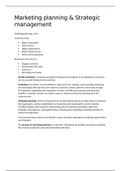Marketing planning & Strategic
management
Marketing planning: Unit 1:
Customers have:
Better information
More choices
Higher expectations
Better market access
More purchasing power
Businesses must plan to:
Engage customers
Demonstrate the value
Gain trust
Win long-term loyalty
Stealth marketing: A company arranges for blog posts that appear to be initiated by consumers
but are actually initiated by the marketer.
Marketing: the activity, set of institutions, and process for creating, communicating, delivering,
and exchanging offerings that have value for customers, clients, partners, and society at large.
This definition emphasizes the importance of value, the difference between the perceived
benefits a customer receives ( to satisfy a want or need) and the perceived total price the
customer pays.
Marketing planning: is the structured process of determining how to provide value to customers,
the organization, and key stakeholders by researching and analysing the current situation,
including markets and customers: determining and documenting marketing’s objectives,
strategies and programs ,and implementing, evaluating and controlling marketing activities to
achieve the objectives.
A structured process helps you to identify, assess and select appropriate marketing opportunities
and strategies.
The purpose of marketing planning is to provide a disciplined yet flexible framework for guiding
the company toward its value and relationship objectives.
, The marketing planning process:
Every business has to prove itself to remain profitable and competitive and therefore, update and
adapt the marketing plan as the market and customers’ needs evolve and as the organization’s
situation, priorities, and performance change.
Contents of a marketing plan:
The marketing plan
Contains much more detail about the coming year’s marketing strategy and implementation
than is included in the business plan.
Includes shorter-term, specific operational direction for how the organization will use
marketing to achieve targeted results.
Content:
1. Executive summary: Brief overview of the main points. Last thing you write.
2. Current marketing situation: Analyses events and trends in the environment that can affect
the organisation, its marketing and its stakeholders.
Internal situation (mission, resources, offerings, previous results, business
relationships)
External situation (political-legal, economic, social-cultural, technological and
ecological forces)
, Competitive situation (current and emerging/ potential competitors, competitive
strategies and advantages)
Market situation (market definition, market share, customer needs and behaviour)
SWOT analysis (internal strengths and weaknesses, external opportunities)
3. Target market, customer analysis, positioning: explains the segmentation, targeting and
positioning decisions. Also discusses the segments to be targeted, with an overview of
customers’ and prospects’needs, wants, behaviors, attitudes, loyalty and purchasing
patterns.
4. Objectives and issues: Outlines specific objectives, in three categories, to be achieved
through the plan, and identifies any issues that may affect the organisation’s ability to
achieve them: 1. Financial objectives 2. marketing objectives 3.Societal objectives.
5. Marketing strategy: Summarizes the overall strategy for achieving objectives by creating,
communicating, and delivering value to the target market(s). Also indicated how marketing
will affect other stakeholders.
6. Marketing programs: Lays out the programs supporting the marketing strategy, including
specific activities, schedules and responsibilities for the following:
Product
Pricing
Place
Promotion
Service
Internal marketing
7. Financial and operational plans: Includes the financial and operational requirements and
results related to marketing programs:
Expected revenues and profits
Projected budgets
Schedules and responsibilities
Additional information or resources needed for planning and implementation
8. Metrics and implementation control: Indicated how the plan will be implemented and
evaluated (including metrics for performance measurement). Shows how and when
adjustments will be made to keep plan on track toward objectives.
Connections with stakeholders are important. Stakeholders are people and organizations that
are influenced by or that can influence company performance. Competitors are also
stakeholders.
Neuromarketing: Using technologies such as functional magnetic resonance imaging or eye
tracking to measure consumer’s physiological reactions to products and marketing.
Segments: Marketers have to apply their knowledge of the market and customers to select
groups within the market.
Purpose of segmentation: To group customers with similar needs, wants, behaviours, attitudes
or other characteristics that affect their demand for or usage of the good or service being
marketed.
Targeting: Whether to market to one segment, several segments, or the entire market and how
to cover those segments.






